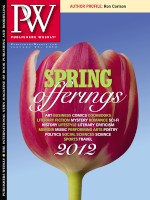I have always loved making stories, and by that I mean the process of making them, taking the words in my head and giving them physical form. A gift of a blank notebook for my eighth birthday inspired my first attempt at a novel. I only got six pages into it, but I took great joy in ruling pencil lines for my sentences. At 10, I spent a year’s worth of pocket money on a typewriter. I still remember the satisfaction its smart click against the page gave me. But in the end I did not love my typewriter. My inability to achieve perfection with it often made me cry. I was too stern for erasing fluid, and I didn’t like processions of errors across a page. At 15, a computer seemed the answer. My parents made me take a typing course, which taught me a great deal about the dating situations of the other students (mainly young women in their 20s) and also how to type fast.
This facility with computers shaped my first two novels. But as I wrote more books I began to think differently about the word processor’s infinite capacity for correction. The child who cried over typographical errors grew into a man obsessed by sentence structure and the details that give it style. In the five years it took me to write The Drowning People (Grand Central, 1999), I changed commas to semicolons, and back again, several hundred times in a relentless quest for perfection. I reordered sentences, flicked clauses to different points on a page, lost myself for days at a time in the endless possibilities of English punctuation and the rich, subtle lexis of our language.
One afternoon in my mid-20s, the universe taught me a lesson. I was caught in a maze of indecision about the structure of my second novel, Us. It was a very hot day and I went to a cafe, trying to make up my mind over a question of chronology. I had written hundreds of pages, and deleted them, and rewritten them, and deleted them, in ways novelists of the pre-computer age could not have done.
I knew I had to make a decision and stick to it. Unable to, in desperation, I flipped a coin. And this is the absolute truth: it landed on its side, neither heads nor tails.
I wrote one more novel entirely on a computer—Natural Elements (Knopf, 2009)—in which I drew on the lesson of the unflippable coin and learned to trust myself more. I had weaned myself of my semicolon obsession, but this time it was adverbs.
It was my diaries that freed me. I write them by hand, with only occasional correction. Their sole audience is my older self, and I am at ease in his presence. When History of a Pleasure Seeker slipped into my mind, I knew that the adventure whose outlines I discerned could not be written while wrestling with lines of Times New Roman on a blank computer screen. The story was set in Amsterdam, at the height of the belle époque. It dealt with luxury and style and the thrilling possibilities of the senses. I had a book made for it—a handsome, hand-stitched book of bright blue leather, the lines already ruled this time, with the title stamped in silver on its cover.
In a book, you can revise. You can cross words out three or four times. You can draw arrows to the margin and add clauses there. But eventually, there is no space left. The text must be what it is. And it is present in all its incarnations.
Of course I typed it as I went along. I couldn’t resist. But I had become suspicious of perfection. It cannot be achieved in language, nor should it be sought. As Charles Rennie Mackintosh knew, there is hope in honest error. Indeed, honesty is the point of fiction. At the end of that manuscript, I wrote a promise to myself on the last page: that I would write the next book to the end before typing any of it.
I have so far written five and a half pages of my new book, which begins five years after History of a Pleasure Seeker closes. Many times I have been tempted to type and revise. So far I have resisted. And each resistance gives me strength.
Richard Mason’s new novel is History of a Pleasure Seeker (Knopf, Feb.).



 Volume 259
Issue 04
01/23/2012
Volume 259
Issue 04
01/23/2012





